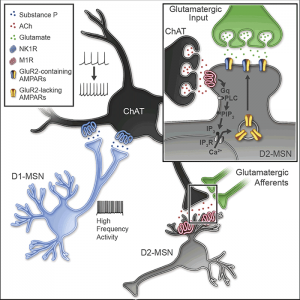 Hot Off the Press – June 16, 2019.
Hot Off the Press – June 16, 2019.
Brain stimulation is used to treat reward-related psychiatric diseases including addiction and treatment resistant depression. We report that high frequency stimulation parameters effective in treating these diseases promote the release of the peptide substance P. Release of this peptide in the Nucleus Accumbens rebalances excitatory input to a neuronal subtype that is known to prevent reward and addiction behaviors. Results from this study provide neurobiological insight in to the mechanisms of Nucleus Accumbens brain stimulation.
Publication Information
High-Frequency Activation of Nucleus Accumbens D1-MSNs Drives Excitatory Potentiation on D2-MSNs. Journal Article
In: Neuron, 2019, ISSN: 1097-4199 (Electronic); 0896-6273 (Linking).
